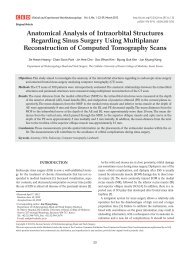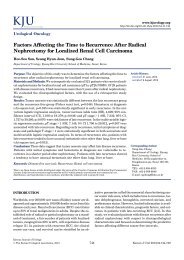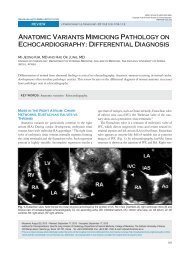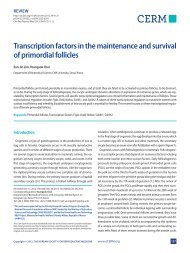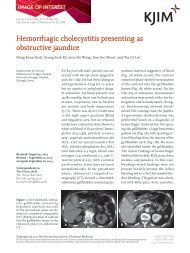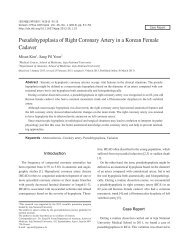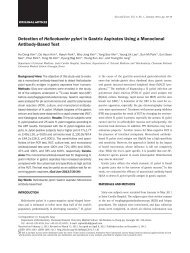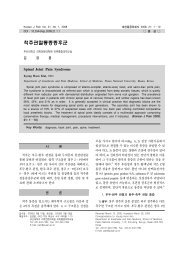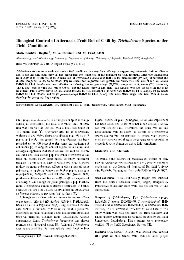The surgical experience for retroperitoneal, mesenteric and omental ...
The surgical experience for retroperitoneal, mesenteric and omental ...
The surgical experience for retroperitoneal, mesenteric and omental ...
You also want an ePaper? Increase the reach of your titles
YUMPU automatically turns print PDFs into web optimized ePapers that Google loves.
So Hyun Nam, et al.<br />
patients presented with one or two clinical symptoms,<br />
such as palpable intra-abdominal mass in 9 patients, abdominal<br />
pain in 5 patients, <strong>and</strong> abdominal distension in 3<br />
patients. Two patients had severe anemia. <strong>The</strong> median duration<br />
of symptoms was 7 days (range, 1 to 365 days). In<br />
one patient, the intra-abdominal mass was incidentally<br />
detected during the evaluation of congenital heart disease<br />
(Table 1).<br />
For imaging diagnosis, ultrasonography or computed<br />
tomography was per<strong>for</strong>med. Lymphangiography was<br />
per<strong>for</strong>med in one patient <strong>and</strong> magnetic resonance imaging<br />
was checked in one patient, respectively. However, despite<br />
imaging studies, the preoperative localization of<br />
cysts was possible only in 3 patients. Based on operative<br />
findings, 10 cysts were located in retroperitoneum, 8 in<br />
omentum, <strong>and</strong> 5 in mesentery. Among 10 <strong>retroperitoneal</strong><br />
cysts, 2 involved the mesentery <strong>and</strong> 1 extended to the<br />
buttock. Among 8 <strong>omental</strong> cysts, 4 extended to the lesser<br />
sac. Among 5 <strong>mesenteric</strong> cysts, 3 were originated in jejunum,<br />
1 in ileum <strong>and</strong> 1 in sigmoid.<br />
<strong>The</strong> median size of cysts was 13 cm (range, 3 to 30 cm) in<br />
largest diameter. Six were smaller than 10 cm, <strong>and</strong> 6 were<br />
larger than 20 cm. <strong>The</strong> nature of cyst fluid was serous in 16<br />
cysts, serousanguinous in 2, chyle in 2, <strong>and</strong> necrotic material<br />
in 1. <strong>The</strong> other 2 cysts contained a lot of blood, which<br />
caused significant anemia. Twenty cysts were completely<br />
removed. Simultaneous bowel resection was needed in 5<br />
<strong>mesenteric</strong> cysts. Three of <strong>retroperitoneal</strong> cysts were impossible<br />
to complete excision because of its location <strong>and</strong><br />
extensiveness of the lesions. OK-432 was injected into the<br />
remaining cyst of buttock after partial excision of <strong>retroperitoneal</strong><br />
cyst in one patient <strong>and</strong> biopsy alone without excision<br />
in 2 <strong>for</strong> multiple <strong>and</strong> extensive <strong>mesenteric</strong> invasion.<br />
<strong>The</strong> pathologic findings showed that 20 masses were lymphangioma<br />
(16 cystic, 4 cavernous type) <strong>and</strong> 3 were pseudocyst<br />
(Table 1).<br />
<strong>The</strong> <strong>surgical</strong> complications after operation occurred in 2<br />
patients. One was adhesive ileus that arose 6 months after<br />
<strong>omental</strong> cyst excision. One was post-operative mortality,<br />
an infant born at 30 weeks of gestational age with fetal<br />
hydrops. He had a 7 cm sized cystic mass at retroperitoneum<br />
<strong>and</strong> mesentery. After biopsy of the mass at age<br />
of 54 days after birth, he suffered from chronic lung dis-<br />
ease, <strong>and</strong> post-<strong>surgical</strong> intra-abdominal infection, <strong>and</strong><br />
died of sepsis 2 weeks after surgery.<br />
During the follow-up period, all but the one death are<br />
doing well with no evidence of recurrence.<br />
DISCUSSION<br />
<strong>The</strong> intra-abdominal cystic masses were classified by location<br />
<strong>and</strong> histology. Besides the solid organs, retroperitoneum,<br />
mesentery, <strong>and</strong> omentum are the possible origin<br />
of the cystic mass. It is difficult to define the location of<br />
the cyst topographically. Many authors suggested that <strong>retroperitoneal</strong>,<br />
<strong>mesenteric</strong>, <strong>and</strong> <strong>omental</strong> cysts should be<br />
grouped together because on the basis of shared embryologic<br />
structures [1-3].<br />
Walker <strong>and</strong> Putnam [4] stated that the size of the lesion<br />
rather than the location appears to be a more important<br />
factor in determining clinical symptomology. <strong>The</strong> intraabdominal<br />
cystic mass could present the three ways:<br />
asymptomatic, chronic abdominal pain, acute abdomen<br />
[1]. Our series showed that most of cysts present with abdominal<br />
mass, pain, <strong>and</strong> distension. 21.7% of cysts were<br />
detected prenatally.<br />
Retroperitoneal, <strong>mesenteric</strong>, <strong>and</strong> <strong>omental</strong> cysts could<br />
cause acute abdomen from cyst rupture, infection, hemorrhage,<br />
volvulus <strong>and</strong> extrinsic compression [1]. In general,<br />
these acute symptoms are more common in children than<br />
adults [1]. Patients under 10 years of age are different from<br />
the older group, having a shorter duration of symptoms, a<br />
higher number of emergency surgeries <strong>and</strong> lower recurrences<br />
[3]. Particularly in children less than 10 years of age,<br />
the average duration of symptoms prior to treatment is 2.2<br />
months, compared to 9.8 months in patients older than 10<br />
years [3]. <strong>The</strong> reason <strong>for</strong> earlier detection in children may<br />
be the smaller body habitus <strong>and</strong> abdominal cavity [5]. Our<br />
study revealed that the median age at operation was 46<br />
months <strong>and</strong> the median duration of symptoms was 7 days.<br />
We observed that most of the <strong>retroperitoneal</strong>, <strong>mesenteric</strong>,<br />
<strong>and</strong> <strong>omental</strong> cysts occurred in young patients in our study.<br />
<strong>The</strong> median diameter of cyst was 13 cm. <strong>The</strong> largest one<br />
was up to 30 cm. It suggests that the peritoneal cyst in children<br />
could become enlarged to the entire abdomen result-<br />
104 thesurgery.or.kr



